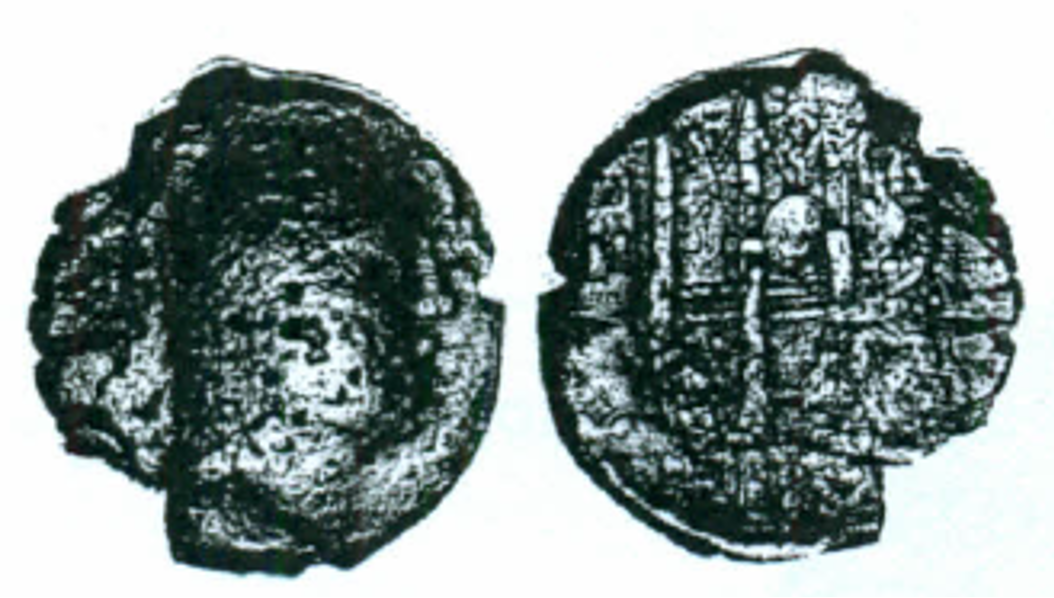2933 - Amphipolis (AE Strymon/trident) over Thessalonica (Dionysus/Pegasus) (MacDonald 1998, 4)
From SILVER
(CSV import-Overstrikes-2022-08-16) |
|||
| Line 1: | Line 1: | ||
{{Overstrike | {{Overstrike | ||
| − | |Private collection= | + | |Image overstriking coin=SO 905 - Amphipolis over Thessalonica.png |
| + | |Image overstruck variety visible on the overstriking coin=Amphipolis over Thessalonica 905.png | ||
| + | |Private collection=David MacDonald collection | ||
|Obverse description=Head of Strymon right, wearing reeds wreath. | |Obverse description=Head of Strymon right, wearing reeds wreath. | ||
|Reverse legend=MAKEΔΟΝΩΝ (N…ΔEO…) | |Reverse legend=MAKEΔΟΝΩΝ (N…ΔEO…) | ||
| + | |Reverse legend language=Greek | ||
|Reverse description=Trident orned with dolphins. In fields, monograms. | |Reverse description=Trident orned with dolphins. In fields, monograms. | ||
|Mint=Amphipolis | |Mint=Amphipolis | ||
|Ancient region=Macedon | |Ancient region=Macedon | ||
| − | |Authority=The Macedonians | + | |Authority=Roman Republic; The Macedonians |
| − | |Date from=168 | + | |Date from=168 BCE |
| − | |Date to=150 | + | |Date to=150 BCE |
| + | |Period=Hellenistic | ||
| + | |Metal=Bronze | ||
|Weight=7.77 | |Weight=7.77 | ||
|Diameter=21 | |Diameter=21 | ||
| − | |Axis=11 | + | |Axis=11 |
|Coin reference=MacDonald 1998, p. 100, n° 1, pl. 1, n° 4. | |Coin reference=MacDonald 1998, p. 100, n° 1, pl. 1, n° 4. | ||
| − | |Coin series reference= | + | |Coin series reference=Gaebler 1935, p. 35-37, n° 59-63 ; HGC 3.1, n° 334 |
|Overstruck obverse description=Head of Dionysos right, wearing ivy wreath (visible: slight traces). | |Overstruck obverse description=Head of Dionysos right, wearing ivy wreath (visible: slight traces). | ||
|Overstruck reverse legend=(Θ)ΕΣ(ΣΑΛΟ)ΝΙΚΗΣ | |Overstruck reverse legend=(Θ)ΕΣ(ΣΑΛΟ)ΝΙΚΗΣ | ||
| + | |Overstruck reverse legend language=Greek | ||
|Overstruck reverse description=Pegasos right. In right field, ear of grain. | |Overstruck reverse description=Pegasos right. In right field, ear of grain. | ||
|Overstruck mint=Thessalonica | |Overstruck mint=Thessalonica | ||
|Overstruck ancient region=Macedon | |Overstruck ancient region=Macedon | ||
| − | |Coin series reference overstruck=Gaebler | + | |Coin series reference overstruck=Gaebler 1935, p. 118, n° 4, tafel XXII, 22 ; Touratsoglou, Circulation, pl. IX.3; Malloy 18. pl. I, 11-13. |
}} | }} | ||
Revision as of 22:56, 28 May 2023
168 BCE - 150 BCE | MAKEΔΟΝΩΝ (N…ΔEO…)
Location/history
| Private collection(s)Private collection(s) ᵖ: | David MacDonald collection |
Overstriking coin
Description
| ObverseInscription or printing placed on the obverse.: | Head of Strymon right, wearing reeds wreath. | ReverseInscription or printing placed on the reverse.: | MAKEΔΟΝΩΝ (N…ΔEO…) (Greek) Trident orned with dolphins. In fields, monograms. |
Mint and issuing power
| MintIdentifies the place of manufacture or issue of a numismatic object.: | Amphipolis | Ancient regionAncient region. | Macedon | Modern countryModern country: Greece | AuthorityIdentifies the issuing power. The authority can be "pretended" when the name or the portrait of X is on the coin but he/she was not the issuing power. It can also be "uncertain" when there is no mention of X on the coin but he/she was the issuing power according to the historical sources: | Roman Republic, The Macedonians |
Chronology
| FromIdentifies the initial date in a range assigned in a numismatic context. 168 BCE toIdentifies the final date in a range assigned in a numismatic context.. 150 BCE | Hellenistic 323-30 BC |
Physical description
| MetalThe physical material (usually metal) from which an object is made.: Bronze |
WeightWeight of the numismatic object (in grams). in grams: 7.777.77 g <br />7,770 mg <br /> | AxisDescribes the directional relationship between the obverse and reverse of a numismatic object.: 1111 mm <br />1.1 cm <br /> | |
| DiameterDescribes diameter of an object (in mm).: 2121 mm <br />2.1 cm <br /> | |||
References
| Coin referenceReference of the Coin: | MacDonald 1998, p. 100, n° 1, pl. 1, n° 4. | Coin series referenceReference to coin series study: | Gaebler 19351Gaebler 1935, p. 35-37, n° 59-63, HGC 3.12HGC 3.1, n° 334 |
Overstruck type
Description
| ObverseInscription or printing placed on the obverse.: | Head of Dionysos right, wearing ivy wreath (visible: slight traces). | ReverseInscription or printing placed on the reverse.: | (Θ)ΕΣ(ΣΑΛΟ)ΝΙΚΗΣ (Greek) Pegasos right. In right field, ear of grain. |
Mint and issuing power
| MintIdentifies the place of manufacture or issue of a numismatic object. ᵖ: | Thessalonica | Ancient regionAncient region. ᵖ | Macedon | Modern countryModern country: Greece | AuthorityIdentifies the authority in whose name (explicitly or implicitly) a numismatic object was issued. ᵖ: |
Chronology
| FromIdentifies the initial date in a range assigned in a numismatic context. toIdentifies the final date in a range assigned in a numismatic context.. | periodTime period of the numismatic object. |
Physical description
References
| Coin type referenceReference to coin series study ᵖ: | Gaebler 19351Gaebler 1935, p. 118, n° 4, tafel XXII, 22, Touratsoglou3Touratsoglou, Circulation, pl. IX.3, Malloy 18. pl. I4Malloy 18. pl. I, 11-13. |
Additional data
| Frequency of overstrikesFrequency of overstrikes: | Level of confidenceLevel of confidence of the identification: | ||
| RemarksRemarks: | |||
References
- a b Gaebler, Hugo (1935), Die antiken Münzen Nord-Griechenlands, unter Leitung von Theodor Wiegand. Band III, Makedonia und Paionia. 2. Abt., Verlag W. de Gruyter, Berlin
- ^ Hoover, Oliver D. (2016), Handbook of coins of Macedon and its neighbors. 3. Part I: Macedon, Illyria, and Epeiros, sixth to first centuries BC, Lancaster, 437 p.
- ^ Touratsoglou
- ^ Malloy 18. pl. I

